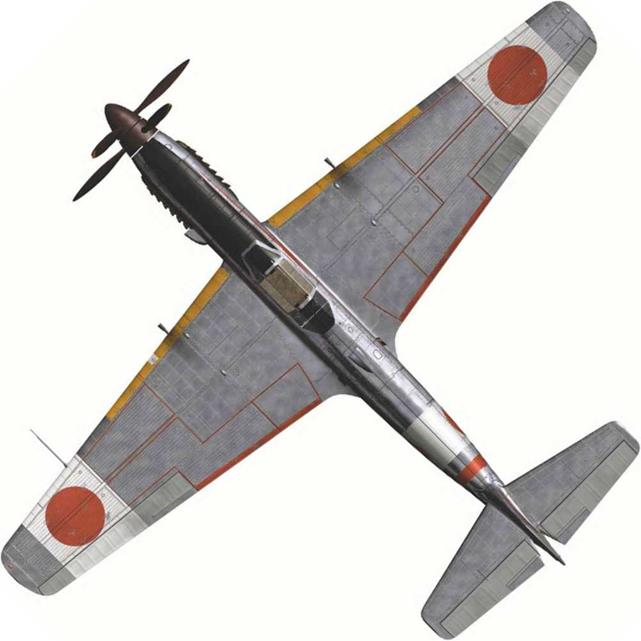Kawasaki Ki-64 – data
Contemporaries
Republic XP-69 (US), Heinkel P.1076 (Germany), Caproni CA.183bis (Italy)
Type Fighter
Crew One
|
Powerplant One Kawasaki Ha-201 ([Ha-72] 11), 24-cylinder, inverted-V, liquid – cooled engine developing 2,350hp at take-off, 2,200hp at 12,795ft, driving two, metal, 3-bladed contra-rotating propellers Dimensions
Armament Two 20mm Ho-5 cannons in the fuselage deck, one 20mm Ho-5 cannon in each wing |
Deployment
None. Only one Ki-64 was completed and flown before the end of the war.


![]()

In August of 1942, the IJA saw a need for a aircraft that, in its primary role, would serve as an interceptor flying sorties to defend installations, airfields and other assets that were considered important and therefore subject to enemy attack. Design specifications were drafted by the IJA for the aircraft and it was Kawasaki who put forth what they felt was the answer: the Ki-88.
Prior to drafting their design specifications, the IJA had sifted through a number of ideas before settling on a plane that had to have a heavy armament to ensure it could inflict significant damage to enemy aircraft, especially bombers, and also good handling characteristics to make it not only a stable gun platform, but also to avoid a steep learning curve for new pilots.
To this end, Tsuchii Takeo, a designer for Kawasaki, began work on what would become the Ki-88. Takeo selected a 37mm cannon as the primary weapon, supported by two 20mm cannons. It is probable that the 37mm Ho-203 cannon and two Ho-5 20mm cannons would serve as the armament fit with all three weapons fitted in the nose. Given the size of the Ho-203 (which was a little over 1.53m (5ft) in length, weighing 88.9kg (196 lb)), this presented a problem in squeezing them, along with the engine, into the
nose. To get around this, Takeo placed the l,500hp Ha-140 liquid-cooled, turbo- (or super-) charged engine in the fuselage, behind the cockpit. The three-bladed propeller was driven using an extension shaft that ran from the engine to a gearbox connected to the propeller. In essence, Takeo built the aircraft around the Ho-203.
The main advantage of placing the engine in the fuselage was that it allowed the cannon to fire through the propeller hub, producing a more stable firing platform that resulted in improved accuracy. Another advantage was that it allowed a skilful designer to make the nose more streamlined, enhancing speed performance.
A good number of references infer that Takeo’s design was inspired by the Bell P-39 Airacobra. While there is no evidence that specifically states that Takeo simply copied the American fighter, the P-39 was in limited operational use by the time design work began on the Ki-88 in 1942, notably seeing action in the Battle of Guadalcanal. Thus, the Japanese were aware of the design. Whether an example was ever captured for analysis is unknown but certainly intelligence was available on the plane. Or, it may be that Takeo arrived at the same conclusion as did H. M. Poyer, designer of the P-39, when looking at
how best to accommodate a large calibre cannon in a single engine aircraft.
In June of 1943, Takeo finalised his design for the Ki-88. Apart from the use of a 37mm cannon and the engine placement, the Ki-88 bore no further resemblance to the P-39. The Ki-88 had a deep fuselage to accommodate the Ha-140 engine that was situated below and to the rear of the cockpit. The air scoop for the Ha-140’s radiator was mounted on the bottom of the fuselage, just forward of the wing roots. The radiator itself was positioned back from the scoop on the bottom interior of the fuselage, almost directly underneath the pilot’s seat. Jutting out on the left side of the fuselage, just above the trailing edge of the wing, was the scoop to provide air to the turbo – or super-charger of the Ha-140. The landing gear was conventional and the main gear retracted into the wings, while the tail wheel was fixed. A fuel tank was provided in each wing, mounted behind the wheel wells. On either side and to the bottom of the Ho-203 cannon were the Ho-5 cannons.
With the final design complete, work began on a full scale mock-up of the Ki-88 and this was completed sometime in 1943. In addition, work had already begun on construction of the fuselage and wings for a prototype and it was expected that by October
1943 the Ki-88 would be nearing completion. The IJA, however, had other plans for the Ki-88. After inspecting the mock-up and in reviewing the projected performance data of the plane, it was seen that it offered no real advantage over other designs then in operational use, notably the Kawasaki Ki-61 Hien. Thus, Kawasaki was ordered to terminate all work on the Ki-88.










